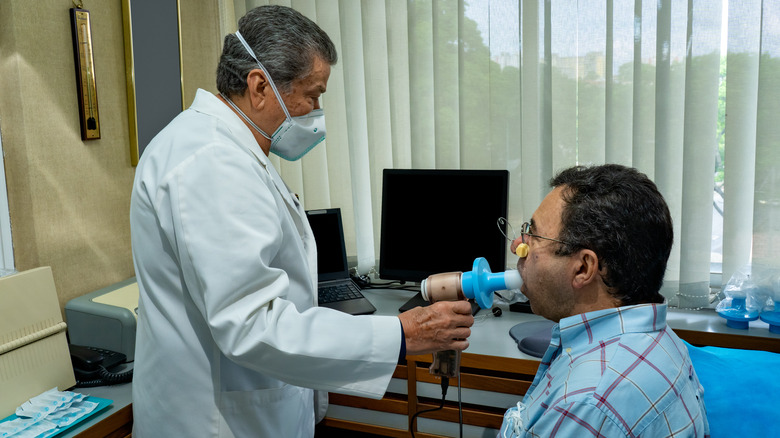Adult-Onset Asthma Explained: Causes, Symptoms, And Treatments
Asthma is a chronic condition that affects the lungs. According to the Mayo Clinic, people with asthma produce extra mucus and their airways narrow and swell, which causes breathing difficulties. Asthma occurs along a gradient, so some people experience mild symptoms while others experience severe disease. Wheezing and shortness of breath are common symptoms of asthma.
Over time, asthma can cause serious complications. Some people experience "airway remodeling," in which the airway walls thicken, blood supply to the airways increases, and mucus production increases. Airway remodeling can also lead to chronic coughing and reduced lung function (per Healthline). Patients with asthma may experience negative side effects, such as throat irritation, hoarseness, oral yeast infections, insomnia, gastroesophageal reflux, and rapid heartbeat, from asthma medications.
According to 2020 data from the Centers for Disease Control and Prevention (CDC), more than 25 million Americans have asthma. Of these, 21 million are adults. People can develop asthma as children or adults. But let's take a closer look at adult-onset asthma.
Adult-onset asthma versus childhood asthma
Many people associate asthma with childhood, and it is a common childhood condition that affects roughly 6% of children (per the CDC). But asthma is actually slightly more prevalent among adults, with just over 8% of adults suffering from asthma. Some adults with asthma had it as children, but others developed it as adults.
Asthma presents differently in adults than in children. According to the Asthma and Allergy Foundation of America, children with asthma often experience symptoms in response to a trigger such as allergies or respiratory infections. Children also tend to experience these symptoms intermittently, typically only after exposure to a trigger. In contrast, people with adult-onset asthma experience persistent symptoms, even in the absence of a trigger, and are more likely to require daily medical treatment.
In addition, adult-onset asthma is often more severe and causes a more rapid decline in lung function when compared to childhood asthma, according to a 2013 review published in the journal European Respiratory Review.
Causes of adult-onset asthma
There is not always an identifiable cause of adult-onset asthma, but some of the most common known causes include recurrence of childhood asthma, external triggers, lifestyle, and gender.
Many children with asthma see their symptoms disappear with age. Adults who had asthma as children may be unpleasantly surprised when they start to experience symptoms again, but recurrence of childhood asthma is not uncommon (per the Asthma and Allergy Foundation of America). In these cases, asthma symptoms tend to reappear in patients in their 30s and 40s who had asthma during their childhoods.
For many other adults, asthma is truly a new condition. A 2018 study from the Journal of Allergy and Clinical Immunology in Practice identified allergies, pneumonia, upper respiratory tract infections, and stressful life events as triggers for asthma in adults newly diagnosed with this condition. Other cases result from lifestyle factors. A 2021 study from the journal Current Allergy and Asthma Reports found that obesity can cause adult-onset asthma and worsen symptoms in patients with asthma.
Gender is another risk factor for developing adult-onset asthma. According to the Asthma and Allergy Foundation of America, the hormonal fluctuations associated with pregnancy and menopause can trigger adult-onset asthma in some women.
Churg-Strauss Syndrome may cause adult-onset asthma
Most cases of adult-onset asthma stem from causes such as infection, allergies, hormonal changes, obesity, and stress. Some, however, result from Churg-Strauss syndrome, a rare condition that is also known as eosinophilic granulomatosis with polyangiitis (EGPA). According to the Mayo Clinic, "Adult-onset asthma is the most common sign of Churg-Strauss syndrome."
The condition is an autoimmune disease that causes a person's immune system to attack healthy tissue instead of invading bacteria and viruses. This immune response causes widespread inflammation throughout the body and can affect many organs including the lungs, sinuses, skin, kidneys, gastrointestinal system, joints, muscles, and heart. Some people experience mild inflammation while others experience more severe inflammation — but almost all patients with Churg-Strauss syndrome develop adult-onset asthma as well as sinusitis.
There is no cure for Churg-Strauss syndrome, but proper treatment allows patients to manage their condition. Steroids and other immunosuppressant drugs can dampen the immune response to reduce systemic inflammation and keep symptoms at bay.
Risk factors for developing adult-onset asthma
A 2019 study in the journal European Respiratory Review identifies several factors that increase the risk of developing adult-onset asthma.
Women are more likely than men to develop adult-onset asthma, perhaps because of shifts in female hormones. For women, incidence of asthma increases with the number of births and, "Likewise, there is evidence that the incidence of asthma is decreased after menopause" (via the European Respiratory Review). The risk of asthma increases with the use of hormone replacement therapy.
Disease and infections are also linked to asthma in adults. Rhinitis, or nasal inflammation that causes a runny nose and congestion (per Johns Hopkins Medicine), along with chronic rhinosinusitis, or sinuses that are inflamed from irritation or infection, are risk factors for adult-onset asthma (via Medical News Today). Also nasal polyps, or benign growths in the nasal passage and sinuses are risk factors too (per the Cleveland Clinic). Acute lower respiratory tract infections such as bronchitis and pneumonia can also trigger adult-onset asthma, according to a 2011 study in the journal PLoS One.
Obesity puts people at greater risk of developing asthma as adults and also increases its severity (per a 2018 study from the Journal of Allergy and Clinical Immunology). When compared to lean adults, obese adults — particularly obese women — are more likely to develop asthma and more likely to be hospitalized for asthma, and do not respond well to standard treatments.
Finally, high-stress life events such as marital problems, divorce or separation, illness of a family member, and conflicts with a supervisor are also associated with adult-onset asthma.
Your genes may put you at risk for adult-onset asthma
One risk factor you cannot control is your genetic predisposition for developing adult-onset asthma. One 2019 study published in the Lancet Respiratory Medicine identified 19 genetic locations associated with adult-onset asthma. Similarly, a 2019 study published in the American Journal of Human Genetics identified 34 genetic variants linked to adult-onset asthma. Interestingly, both studies found that the genetic regions associated with adult-onset asthma had a smaller effect on asthma than regions associated with childhood asthma, meaning that adult-onset asthma is less heritable than childhood asthma. These results suggest that adult-onset asthma is more strongly influenced by environmental factors than by genetics.
Many researchers are investigating how epigenetic factors affect the risk of developing asthma. If you think of your genome as an instruction manual and each gene as a paragraph, then epigenetic factors tell you which paragraphs to read. People may "turn on" risk factor genes when they become exposed to environmental factors such as nutrition, obesity, and pollution, according to a 2015 study published in the journal International Forum of Allergy and Rhinology.
Your job may be behind your adult-onset asthma
If you face exposure to certain sensitizers or irritants at your job, you may be at risk of developing adult-onset asthma, or you may have already developed this condition. According to Johns Hopkins Medicine, occupational exposure to sensitizers or irritants such as dusts, gases, vapors, and fumes cause 10-25% of adult asthma cases.
Common triggers include animal hair and dander, small insects, fumes from metal refining and manufacturing, chemical dusts and vapors from manufacturing, and dusts from animals, food products, and fabric. Millers and bakers, people who work with animals, people who work in metal refineries or manufacturing, and people who work in manufacturing of paint, insulation, mattresses, upholstery, packaging, and plasticizers are all at risk of occupational asthma.
While the symptoms of occupational asthma are the same as those of adult-onset asthma, they can be reversed. Most cases of occupational asthma resolve themselves once the individual removes themselves from exposure to the irritants. Continued exposure, unfortunately, can lead to permanent lung damage. Medication, breathing aids, and physical therapy can also help manage the symptoms.
Symptoms of adult-onset asthma
The symptoms of adult-onset asthma are no different than any other asthma symptoms (per the Asthma and Allergy Foundation of America). They may include wheezing, a dry cough, tightness or pressure in the chest, feeling short of breath after exercise, difficulty breathing, and experiencing a cold that lingers. You should talk to your doctor about the possibility of adult-onset asthma if you start to experience these symptoms. Your doctor can perform tests to check for asthma and conditions that cause similar symptoms.
The symptoms of adult-onset asthma overlap with the symptoms of other conditions. For example, chronic obstructive pulmonary disease (COPD) causes many asthma-like symptoms, such as difficulty breathing, shortness of breath after exercise, and wheezing (per the Cleveland Clinic). Congestive heart failure can cause shortness of breath, coughing, and wheezing (via Healthline).
Stomach problems like gastroesophageal reflux disease (GERD) can cause a chronic cough (per Medical News Today). Because there is so much overlap between symptoms of asthma and other serious conditions, it is critical that patients seek medical attention and get a correct diagnosis to ensure proper treatment.
Your doctor can diagnose you with adult-onset asthma
If you have symptoms of adult-onset asthma, you should talk to your doctor. He or she can discuss your symptoms with you, thoroughly examine you, and order the tests that are necessary to diagnose you with asthma and rule out other conditions such as COPD, congestive heart failure, and GERD.
One diagnostic test your doctor may order is spirometry, which tests your lung function. Here, you will blow into a tube connected to a spirometer, then take a breath in. According to the Mayo Clinic, this test measures how much air you can inhale and exhale. A chest X-ray can also help diagnose adult-onset asthma by providing your doctor with a good look at your lungs (per the Cleveland Clinic). According to the National Heart, Lung, and Blood Institute, your doctor may also order a fractional exhaled nitric oxide (FeNO) test, which can detect inflammation in your lungs, as well as blood and skin tests to determine whether allergies are triggering your asthma.
How to manage adult-onset asthma
With proper treatment, many patients successfully manage the symptoms of adult-onset asthma. A 2015 review in the journal Australian Family Physician provides information about a tiered treatment protocol for adult-onset asthma patients. Patients should start by using low-dose, inhaled corticosteroids as well as inhaled short-acting beta agonists. Patients with severe symptoms may require short-term treatment with high-dose, inhaled steroids and/or oral steroids. Patients who respond to this treatment and find that it controls their symptoms should gradually reduce the steroid dosage until they find the minimum necessary dosage.
For some patients, a low-dose, inhaled corticosteroid may not be sufficient to manage their asthma. These patients may need to use an inhaled corticosteroid with a long-acting beta-2 agonist. In addition, patients with adult-onset asthma may need to use oral steroids for acute flareups or severe asthma.
To properly treat asthma, it is critical to use the inhaler correctly. Doctors must take the time to thoroughly instruct new patients on how to use the inhaler. If the inhaler treatment does not seem to be working, doctors should assess patients to make sure they are using it properly.
Additional treatments may help manage adult-onset asthma
While oral and inhaled corticosteroid treatments help many patients, they do not help everyone with adult-onset asthma (per a 2013 review from the journal European Respiratory Review). Researchers continue to explore new ways to treat adult-onset asthma. Monoclonal antibody treatments are a promising development.
According to the National Cancer Institute, monoclonal antibodies are proteins made in a lab that mimic immune system proteins naturally created by the human body. They recognize specific targets in the body that contribute to a specific condition, in this case, asthma. Three monoclonal antibody therapies show promise: omalizumab, mepolizumab, and lebrikizumab (via European Respiratory Review). These treatments target the immune system components IgE, Il-5, and Il-13, respectively. By targeting and reducing them, monoclonal antibody treatments reduce the autoimmune response causing asthma symptoms.
Another treatment that may treat adult-onset asthma is bronchial thermoplasty (per a 2018 study from the Annals of Thoracic Medicine). It uses radiofrequency energy to ablate smooth muscle in the airways, reducing "bronchial obstruction" and "hyperresponsiveness." The Food and Drug Administration (FDA) approved bronchial thermoplasty for adult patients whose asthma is not controlled with high-dose inhaled corticosteroids and long-acting beta-agonists, and current work focuses on whether it can help patients with adult-onset asthma.
For patients whose adult-onset asthma is linked to obesity, bariatric surgery is another option. A 2019 review published in the journal European Respiratory Review showed that obese patients with asthma had improvements in asthma control, medication use, and airway hyperresponsiveness after bariatric surgery. Some patients no longer required asthma treatment at all.
You should create an asthma action plan
The American Lung Association recommends that all people with asthma create an Asthma Action Plan, which is a written plan for asthma management. If you have adult-onset asthma, work with your doctor to create a plan for yourself. This tool can help you monitor symptoms, keep track of your medications, and guide you in an emergency.
Your Asthma Action Plan should include your triggers, symptoms of worsening asthma, and symptoms of severe asthma. It should also include a list of your preventative medications and corresponding dosages as well as a list of your quick-relief medications and their dosages for episodes of increased symptoms. Lastly, include instructions on what to do in case of a severe flare-up.
Be sure to add the phone number for the emergency department, your doctor's emergency number, the number of a family or friend for support, and transportation information. You may not think clearly during a medical emergency and having this information in one place can help you get the care you need in a stressful time.
Prognosis for patients with adult-onset asthma
Remission from asthma is more common in children than in adults. A 2021 study published in the Journal of Allergy and Clinical Immunology in Practice examined remission rates in patients diagnosed between ages 0 and 11 (early-diagnosed asthma), between ages 12 and 39 (intermediate-diagnosed asthma), and age 40 and higher. Only 5% of patients with late-diagnosed asthma went into remission compared to 17.9% of intermediate-diagnosed patients and 30% of early-diagnosed patients.
While remission is rare, patients can control asthma with proper medication and management strategies. According to Medical News Today, patients with asthma should monitor their symptoms daily so that they can quickly notice a flare-up. They should also take their preventative medication as prescribed to keep symptoms at bay and seek additional treatment for acute flare-ups.
Lifestyle and environment management can also help reduce exacerbation of adult-onset asthma. Reducing exposure to lung irritants helps many asthma patients. And, of course, quitting smoking and avoiding allergens can prevent triggering asthma symptoms.













